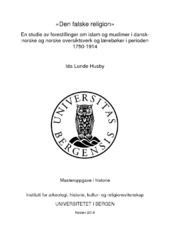| dc.description.abstract | This master thesis has its focus on the perceptions of Islam and Muslims in textbooks and reference works published or read in Denmark-Norway and Norway during the 18th and 19th century. More specifically, the period investigated, spans from 1750 to 1914. The thesis’ aim is to explore which perceptions were dominant in Denmark-Norway and Norway during this period. A broad time span is used to easier spot whether these perceptions changes over time. Part of the field´s research literature argue that hegemonic perceptions in the Middle Ages also appear in modern times. In addition, the research literature show that new ideas about Islam and Muslims also appear during the 18th and 19th century. My aim in this thesis is to extract key topics used in the representation about Islam and Muslims and to analyze whether these topics change over time. The prophet Muhammad and the perceptions of his character are examples of such key topics. Another example is the notion of Islam as a false religion. Textbooks and reference works are studied because they most likely accounted for much of the information about Islam and Muslims given to the Norwegian public. The works in this thesis are selected due to their extensive descriptions of Islam and Muslims. Important underlying notions for the thesis are political relations in Europe with the decline of the Ottoman Empire, as well as religious policies in Norway. During the 19th century the position of the Lutheran Church in Norway changes. The “dissenter act” of 1845 allowed Christian denominations outside the Norwegian State Church to practice their religion. However, this toleration did not mean that other Christian denominations and other religions were met with understanding and respect. This thesis show that hegemonic perceptions of the Middle Ages also prevailed during early modern times. In addition, the study shows that the stereotypes were persistent, especially within certain genres. The decline of the Ottoman Empire, with the West now entering a more dominant position, didn’t have much impact on these stereotypes. Neither did more liberal religious laws in Norway during the 19th century. On the other hand, the thesis will show that some genres focus on the relationship between state and church and warn against theocratic regimes. The works put the Islamic world at the center of these warnings. This focus was rarely present during the 18th century. | en_US |
